Josh and I have been watching the Beijing Olympics today on the Thai national broadcast station, NBT. Although we can't understand the narration, we are really enjoying it: they are doing a great job with almost non-stop coverage, and VERY few commercials. Although they are focusing (understandably) on events where Thai athletes are competing, they are also showing a good mix of other sports.
(Plus, I watched the Opening Ceremonies the other night with NO commercial breaks! Take that, NBC!)
We just watched the 53-kg women's weightlifting competition, which was won by the Thai contender, Jaroenrattanatarakoon Prapawadee (they have been shortening her name to Prapawadee on the displays, for conciseness). She set a new Olympic record, too-- there is going to be a lot of celebrating here!
Sunday, August 10, 2008
Thursday, July 31, 2008
Interesting NYT article about our neighborhood
Today, I was pointed to an interesting New York Times article about "Soi Arab", a small street that forms the center for the local Muslim tourist community. This is just around the corner from our apartment.
To get to Sukhumvit Road and the Skytrain, Josh and I frequently walk down through this area. It's a fascinating experience-- a bit of sensory overload, true, but a glimpse of a tourist "experience" different from what we are used to. There are lots of interesting restaurants that we need to try, and quite a few incense shops (as mentioned in the article). The latter shops interest me because they sell agarwood/aloeswood, which is one of the most prized incense ingredients in the world and the major incense material in historical Japan (where high-grade aloeswood is known as kyara). I've often thought about duplicating some of the Heian-period incense recipes, but the price and scarcity of aloeswood held me up. It's good to know that I can at least go around the corner and get a whiff of what the good stuff is like, even if I can't afford it.
Boring historical aside over, we should try and get some pictures of Soi 3 and Soi 3/1 at some point.
To get to Sukhumvit Road and the Skytrain, Josh and I frequently walk down through this area. It's a fascinating experience-- a bit of sensory overload, true, but a glimpse of a tourist "experience" different from what we are used to. There are lots of interesting restaurants that we need to try, and quite a few incense shops (as mentioned in the article). The latter shops interest me because they sell agarwood/aloeswood, which is one of the most prized incense ingredients in the world and the major incense material in historical Japan (where high-grade aloeswood is known as kyara). I've often thought about duplicating some of the Heian-period incense recipes, but the price and scarcity of aloeswood held me up. It's good to know that I can at least go around the corner and get a whiff of what the good stuff is like, even if I can't afford it.
Boring historical aside over, we should try and get some pictures of Soi 3 and Soi 3/1 at some point.
Saturday, July 19, 2008
Driving!
Yesterday I screwed up my courage and embarked on a new adventure: driving in Bangkok!
We didn't bring either of our cars with us to Thailand, figuring that we would see how things went, and pick one up if we needed one. It turns out that one of our friends had two cars and was only using one-- so we are now the proud owners of a comfy Toyota Corolla. Hondas and Toyotas and the like are great cars to drive around here, because the parts are readily available and service is cheap. American auto makers such as Ford *do* have a presence here (something I wasn't expecting!) but service is a little harder to come by. Essentially, it's the reverse situation from back in the States.
Thursday and Friday were holidays here, and the traffic was light, so Josh persuaded me that it would be a good time to try getting out on the road. So, I drove over to meet him for lunch. Below is a handy Google Map of my route (from C to B and back):
View Larger Map
Fortunately, no bodily or property damage ensued! I was also able to pick up frozen groceries without having to lug them home by hand, which was nice!
The car is a US car, so the steering wheel is on the left...but here in Thailand, you drive on the left, so that has been the first thing to get used to! Fortunately, traffic tends to be very fluid, so as long as we keep an eye out and "go with the flow", it is really not all that crazy. The hardest thing to get used to are the ubiquitous mopeds and motorbikes that weave in and out of traffic, so "no sudden moves" is a safe strategy when driving a car!
Yesterday we also picked up a new Garmin car navigation system, to make our travels easier. Garmin has a huge presence here in Thailand, and they produce some really excellent and detailed maps for the whole country, in both English and Thai. We ended up buying a nuvi 200 GPS in English (they also have them in Thai), which is identical to one we'd get in the USA, except that the Thailand maps are pre-loaded on the unit. When we travel back to the US we'll get a card with the latest US maps and pop it in. Easy!
We intend to use the car mostly for trips out of town, rather than daily commuting. We are thinking of going to the beach (probably Koh Samet) in a few weeks, and we also want to make some day trips to places like Ayutthaya, the Kao Yai National Park, and similar. Watch this space for details!
We didn't bring either of our cars with us to Thailand, figuring that we would see how things went, and pick one up if we needed one. It turns out that one of our friends had two cars and was only using one-- so we are now the proud owners of a comfy Toyota Corolla. Hondas and Toyotas and the like are great cars to drive around here, because the parts are readily available and service is cheap. American auto makers such as Ford *do* have a presence here (something I wasn't expecting!) but service is a little harder to come by. Essentially, it's the reverse situation from back in the States.
Thursday and Friday were holidays here, and the traffic was light, so Josh persuaded me that it would be a good time to try getting out on the road. So, I drove over to meet him for lunch. Below is a handy Google Map of my route (from C to B and back):
View Larger Map
Fortunately, no bodily or property damage ensued! I was also able to pick up frozen groceries without having to lug them home by hand, which was nice!
The car is a US car, so the steering wheel is on the left...but here in Thailand, you drive on the left, so that has been the first thing to get used to! Fortunately, traffic tends to be very fluid, so as long as we keep an eye out and "go with the flow", it is really not all that crazy. The hardest thing to get used to are the ubiquitous mopeds and motorbikes that weave in and out of traffic, so "no sudden moves" is a safe strategy when driving a car!
Yesterday we also picked up a new Garmin car navigation system, to make our travels easier. Garmin has a huge presence here in Thailand, and they produce some really excellent and detailed maps for the whole country, in both English and Thai. We ended up buying a nuvi 200 GPS in English (they also have them in Thai), which is identical to one we'd get in the USA, except that the Thailand maps are pre-loaded on the unit. When we travel back to the US we'll get a card with the latest US maps and pop it in. Easy!
We intend to use the car mostly for trips out of town, rather than daily commuting. We are thinking of going to the beach (probably Koh Samet) in a few weeks, and we also want to make some day trips to places like Ayutthaya, the Kao Yai National Park, and similar. Watch this space for details!
Monday, July 14, 2008
Cambodia -- Tonle Sap Lake Village
Greetings-- it's Ellen again (finally!)
By the end of our second day in Siem Reap, we were pretty much "templed out"...something that must be pretty common! Our guide, Mr. Vith, suggested that on the third morning we take a boat trip down the river onto the Tonle Sap to visit one of the Lake Villages, Chong Khneas.
The Tonle Sap is a huge freshwater lake/river system. Most of the time it's pretty big, but in the rainy season, the Mekong River actually reverses its course and flows *into* the lake, causing it to grow to over twice its dry season size. At the time we were there, the rains were just beginning, and the floods were a few months away.
The road south out of town started out in good condition, but gradually deteriorated into a rutted dirt track.

The road is elevated a few meters above the surrounding marshlands, and the houses are built on stilts to be at road level. Many of the houses were built by squatters.

We had stopped back in town to pay for our boat tickets (it is organized by a central company). Once we got to the end of the road, our guide located a boat, and we set out on the river.
We passed numerous other boats along the way, and a couple of floating barges holding the local primary school. The water level will rise by several meters in the rainy season, putting all the marsh grasses, etc. underwater-- so having everything float is a smart idea!
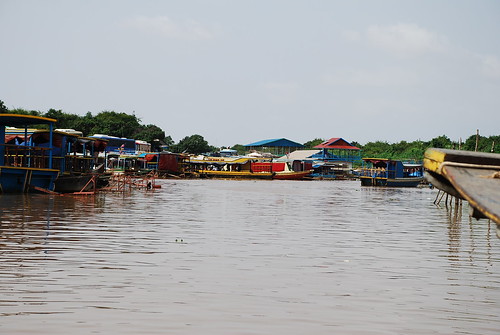
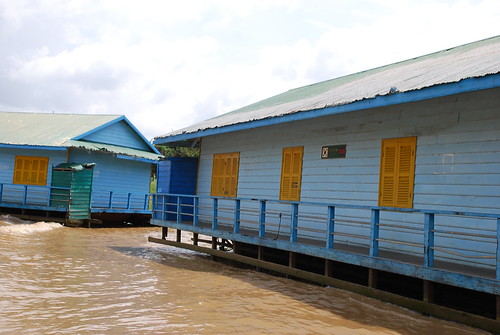
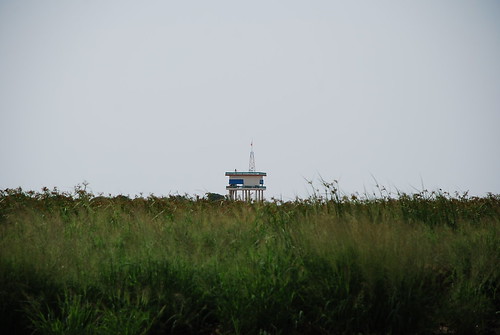
There is even a floating "rec center", with an enclosed basketball court:
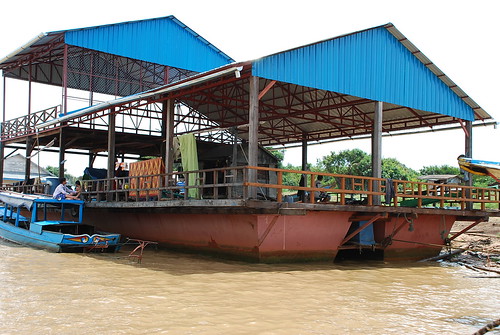
The river then opened up onto the Tonle Sap itself, and we could see the floating village:
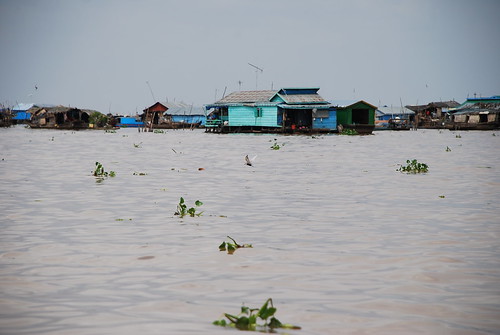
There are several of these floating villages on the lake, but this is one of the most frequented by tourists, thanks to its proximity to Siem Reap. Most of the folks on the lake are actually ethnic Vietnamese rather than Cambodian, but our guide told us that there are pretty well divided "neighborhoods" within the village. (Here, at least it's relatively easy to move house if you don't like your neighbors...)

Life is hard here, and most people are engaged in subsistence fishing, etc. There is a great deal of innovation, with folks creating floating chicken coops, "fields", etc...
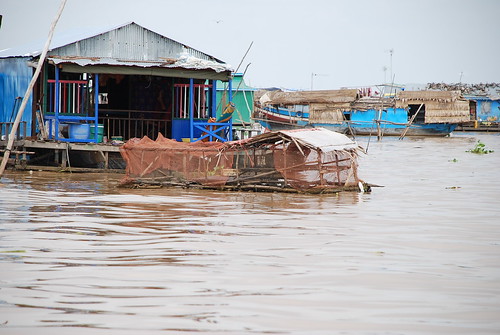

We stopped at a floating tourist center, with a great display on the lake's fish and waterbirds (as well as traditional fishing methods), a small shop and a chance to view some local residents:

There is even a church, which attracts many people to services by promising them a free meal afterwards. Not entirely sure how I feel about that, honestly...
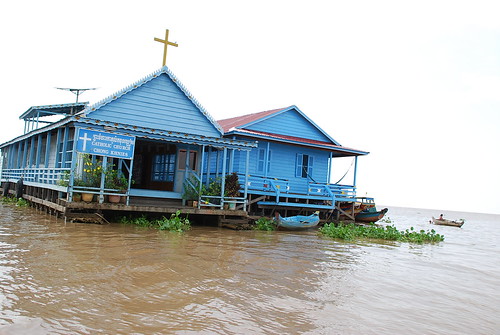
All in all, it was a really eye-opening experience to see how differently people lived. The same was true for the entire Siem Reap trip, for me: I felt like an obscenely rich person casting an imperious eye at the "quaint native customs", and that assessment isn't really far off the mark for any Westerner that comes here.
It really is true: how you live is, in great part, a fluke of where you were born. But no matter where you are, people are always finding creative ways of meeting their needs.
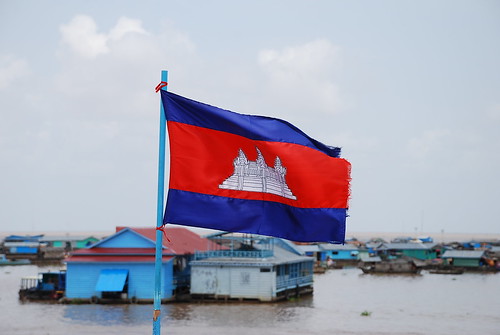
By the end of our second day in Siem Reap, we were pretty much "templed out"...something that must be pretty common! Our guide, Mr. Vith, suggested that on the third morning we take a boat trip down the river onto the Tonle Sap to visit one of the Lake Villages, Chong Khneas.
The Tonle Sap is a huge freshwater lake/river system. Most of the time it's pretty big, but in the rainy season, the Mekong River actually reverses its course and flows *into* the lake, causing it to grow to over twice its dry season size. At the time we were there, the rains were just beginning, and the floods were a few months away.
The road south out of town started out in good condition, but gradually deteriorated into a rutted dirt track.

The road is elevated a few meters above the surrounding marshlands, and the houses are built on stilts to be at road level. Many of the houses were built by squatters.

We had stopped back in town to pay for our boat tickets (it is organized by a central company). Once we got to the end of the road, our guide located a boat, and we set out on the river.
We passed numerous other boats along the way, and a couple of floating barges holding the local primary school. The water level will rise by several meters in the rainy season, putting all the marsh grasses, etc. underwater-- so having everything float is a smart idea!



There is even a floating "rec center", with an enclosed basketball court:

The river then opened up onto the Tonle Sap itself, and we could see the floating village:

There are several of these floating villages on the lake, but this is one of the most frequented by tourists, thanks to its proximity to Siem Reap. Most of the folks on the lake are actually ethnic Vietnamese rather than Cambodian, but our guide told us that there are pretty well divided "neighborhoods" within the village. (Here, at least it's relatively easy to move house if you don't like your neighbors...)

Life is hard here, and most people are engaged in subsistence fishing, etc. There is a great deal of innovation, with folks creating floating chicken coops, "fields", etc...


We stopped at a floating tourist center, with a great display on the lake's fish and waterbirds (as well as traditional fishing methods), a small shop and a chance to view some local residents:

There is even a church, which attracts many people to services by promising them a free meal afterwards. Not entirely sure how I feel about that, honestly...

All in all, it was a really eye-opening experience to see how differently people lived. The same was true for the entire Siem Reap trip, for me: I felt like an obscenely rich person casting an imperious eye at the "quaint native customs", and that assessment isn't really far off the mark for any Westerner that comes here.
It really is true: how you live is, in great part, a fluke of where you were born. But no matter where you are, people are always finding creative ways of meeting their needs.

Saturday, July 5, 2008
The Temples of Angkor: Part II

Although Angkor Thom and Angkor Wat are the most famous of the monuments, if you are really going to see everything you will need to have a driver and a guide. We hired Mr. Ou Niv Vith (Tel: (855) 12 97 26 11) to take us around. His English is excellent--he used to be a school teacher, but by taking the test to become a guide he could make more money. It is still highly recommended that you do your research ahead of time--it will make it much more interesting and, not entirely unsurprisingly, the latest research is not always in the hands of the local guides.
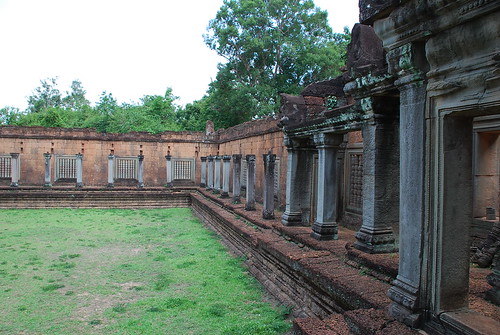
Much of the temples near Siem Reap remain covered by jungle--some are still inaccessible due to mines left over from the Cambodian civil war and, later, their war with Vietnam. In the coming decade, who knows what more will be revealed?
Banteay Samre, shown above, is not so hidden in the jungle, but is off the beaten track--though not so much so that there weren't people there catering to the tourists. Still, it is deinitely one of the less well-known beauties of Angkor Wat.

And the beauty isn't just in the temples. This rainbow showed itself--we saw it 360 degrees around the sun, apparently filtered through the moisture in the atmosphere. I'd heard of pilots seeing this kind of phenomenon, but was taken aback when we saw it here. Fortunately, one of the buildings at Banteay Srei helped to block out the sun so that we could take this picture.

The temple itself was carved with myriad delicate carvings, in a distinctive red sandstone that really brought out the light and shadow of the haut relief carvings throughout. That they have survived since the 8th or 9th centuries is absolutely incredible.

Nearby Banteay Srei is a less decorative but no less impressive monument--Preah Rup. Built as a funerary temple for the king and the royal family, it still stands today--the black smoke of ancient royal cremations can still be seen on inside of the two crematoriums.
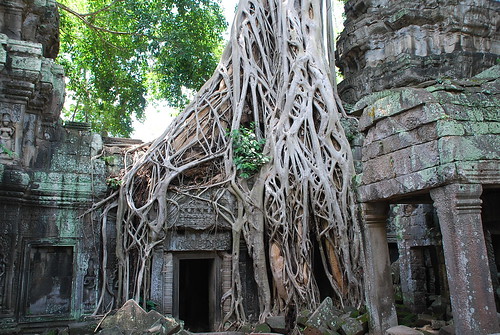
For your truly 'jungle' temples, you really can't beat Ta Prom. It was actually used as a set for "Tomb Raider", and is one of the most distinctive temples with the trees having overgrown so many of the walls. Although the trees are continuing their slow process of tearing down the temple, conservation work is very careful of the fact that today the trees are as much a part of the heritage of this site as anything else.
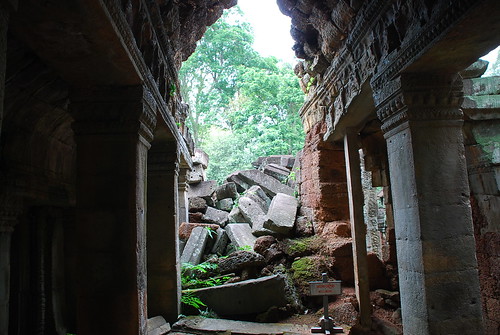
The ruined temple of Preah Khan is also secreted within the jungle. It is actually the yang to the yin of Ta Prom, having been built for the king's father, while Ta Prom was built for his mother. The dilapidated ruins still give voice to the king's filial piety, for as you approach the center where his father's coffin was placed, the doorways grow smaller and smaller, until you are forced to bow before him, no matter how noble you may be.
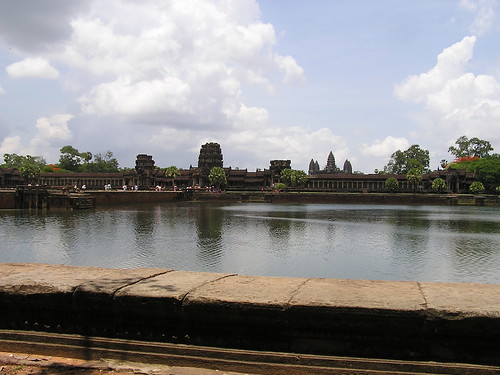
But for all the searching around in the woods, we still come back to Angkor Wat as the most impressive single religious complex in the area.
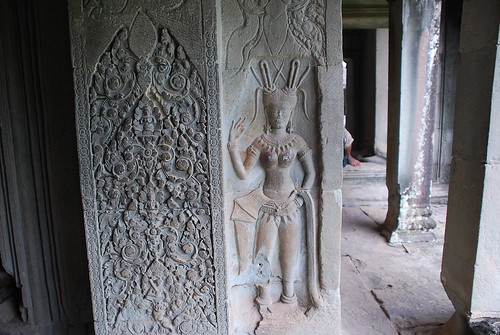
Inside, the complex is just as impressive, with carvings around the lower galleries showing famous stories, including the story of Ramayana and the Churning of the Sea of Milk.

The towers of Angkor Wat are perhaps the most famous view, however. It is used on the Cambodian flag, and has been so since the mid 19th century. Oddly, for all of its stature, we know very little of why the temple was built--and why it differs from so many other temples, facing west, towards the setting sun, rather than east, towards the rising sun.

The most important structure in Angkor, however, contains the least decoration. The west baray was the largest of several man-made reservoirs that supplied water to the city and the fields. It was their ability to tame the waters in these large reservoirs that gave the early Khmer the ability to grow three crops of rice a year and thus support their flourishing civilization. Unfortunately, much of the canals and aqueducts have been lost to the jungles, and people are only now figure out how to recreate them and hopefully reinvigorate the agriculture in and around Siem Reap.
To be continued...
Sunday, June 22, 2008
The Temples of Angkor: Part I

Nestled deep in the jungles of Southeast Asia lies one of the largest religious compounds ever created--the temples of Angkor, popularly known as Angkor Wat.
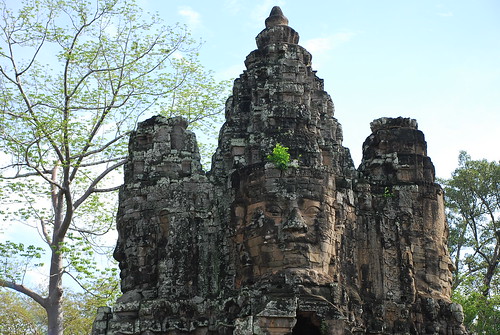
Angkor comes from an ancient word meaning 'capital', and this area was, in fact, the capital and center of the great Khmer empire. The largest palace and temple complex is called Angkor Thom, established by King Jayavarman VII in the late 12th century. You may recall his visage from our trips in Thailand, as he had his face carved everywhere as the face of the Buddha himself.

A Chinese explorer, Zhou Daguan, described his visit to Angkor in the late 13th century. He describes these figures pulling on a naga, or serpent. They represent an important Hindu story: The churning of the sea of milk. Supposedly, the devas (angels) and ashura (devils) pulled on naga, wrapped around an upside-down mountain in the sea of milk, to churn it to produce the elixir of immortality. The story is quite involved and serves as a creation myth for many different things.
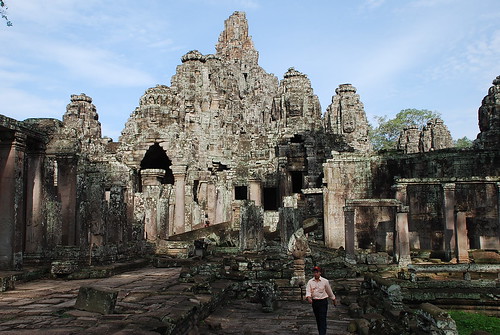
The Bayon is the primary temple of the city complex. It is a 3-level Buddhist mountain temple, with nearly 200 faces of the Buddha (or, as I mentioned, Jayavarman VII). However, while impressive, that is not the most important feature to archaeologists.
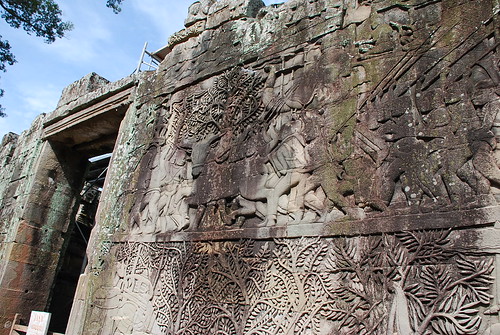
Around the galleries are an impressive array of bas reliefs--and besides the written account of Zhou Daguan, this is some of the only records we have of how the Khmer people lived.
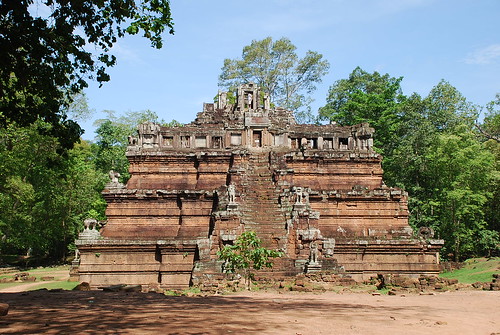
Less impressive, but no less important, is Phimeanakas. This is believed to have been the seat of Khmer kingship, where the ruler would ascend every night to ensure peace and tranquility throughout the realm by appeasing the naga who was the spirit of the land. Behind this structure was the royal palace, but it was made of wood and nothing significant remains.

Other stone structures remain as well, but little or nothing remains of the wooden buildings that were once located within these walls. At 3km at a side, the city was huge. Protected by a moat which was part of an ingenious hydrological system that helped keep the fields of Angkor fertile. In its heyday, Angkor could raise three crops of rice a year. Now, that is only possible for those living directly on the river. However, recent discoveries may allow better irrigation once again, and the past may hold some clues for the future of Cambodia.

To be continued....
I've been reading anything I can get my hands on about Thailand recently, and one thing that caught my eye was the story of Tongdaeng (Copper), His Majesty King Bhumibol Adulyadej's pet dog:
http://www.belovedking.com/tongdaeng_eng/index_eng.html
A fascinating read and a great story. Good for Tongdaeng!
http://www.belovedking.com/tongdaeng_eng/index_eng.html
A fascinating read and a great story. Good for Tongdaeng!
Subscribe to:
Posts (Atom)